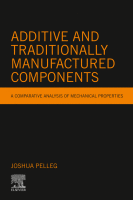Browse content
Table of contents
Actions for selected chapters
- Full text access
- Book chapterAbstract only
Chapter One - What is additive manufacturing?
Pages 1-2 - Book chapterAbstract only
Chapter Two - Fabrication
Pages 3-47 - Book chapterAbstract only
Chapter Three - Testing: Comparison of AM data with traditionally fabricated
Pages 49-176 - Book chapterAbstract only
Chapter Four - Dislocations in AM and traditional manufacturing: A comparison
Pages 177-223 - Book chapterAbstract only
Chapter Five - Deformation in AM and traditional manufacturing: A comparison
Pages 225-288 - Book chapterAbstract only
Chapter Six - Dynamic deformation
Pages 289-375 - Book chapterAbstract only
Chapter Seven - Time-dependent deformation creep in AM and traditional manufacturing
Pages 377-420 - Book chapterAbstract only
Chapter Eight - Cyclic deformation (fatigue) in AM and traditional manufacturing: A comparison
Pages 421-497 - Book chapterAbstract only
Chapter Nine - Fracture in AM and traditional manufactured components
Pages 499-585 - Book chapterAbstract only
Chapter Ten - Comparison of deformation in AM and CP nanomaterials
Pages 587-633 - Book chapterNo access
Chapter Eleven - Epilogue
Pages 635-637 - Book chapterNo access
Index
Pages 639-642
About the book
Description
Additive and Traditionally Manufactured Components: A Comparative Analysis of Mechanical Properties looks at the mechanical properties of materials produced by additive manufacturing (AM) and compares them with conventional methods. Since the production of objects by AM techniques can used in a broad array of materials, the alloys presented are the ones most commonly produced by AM - Al alloys, Ti alloys and steel. The book explores the six main types of techniques: Fused Deposition Method (FDM), Powder Bed Fusion (PBF), Inkjet Printing, Stereolithography (SLA), Direct Energy Deposition (DED) and Laminated Object Manufacturing (LOM), and follows with the techniques being utilized for fabrication.
Testing of AM fabricated specimens, including tension, compression and hardness is included, along with a comparison of those results to specimens obtained by conventional fabrication methods. Topics covered include static deformation, time dependent deformation (creep), cyclic deformation (fatigue) and fracture in specimens. The book concludes with a review of the mechanical properties of nanoscale specimens obtained by AM.
Additive and Traditionally Manufactured Components: A Comparative Analysis of Mechanical Properties looks at the mechanical properties of materials produced by additive manufacturing (AM) and compares them with conventional methods. Since the production of objects by AM techniques can used in a broad array of materials, the alloys presented are the ones most commonly produced by AM - Al alloys, Ti alloys and steel. The book explores the six main types of techniques: Fused Deposition Method (FDM), Powder Bed Fusion (PBF), Inkjet Printing, Stereolithography (SLA), Direct Energy Deposition (DED) and Laminated Object Manufacturing (LOM), and follows with the techniques being utilized for fabrication.
Testing of AM fabricated specimens, including tension, compression and hardness is included, along with a comparison of those results to specimens obtained by conventional fabrication methods. Topics covered include static deformation, time dependent deformation (creep), cyclic deformation (fatigue) and fracture in specimens. The book concludes with a review of the mechanical properties of nanoscale specimens obtained by AM.
Key Features
- Thoroughly explores AM processes that can be utilized for experimental design
- Includes a review of dislocations observed in specimens obtained by AM
- Compares the impact of both additive and traditional manufacturing techniques on the mechanical properties of materials
- Thoroughly explores AM processes that can be utilized for experimental design
- Includes a review of dislocations observed in specimens obtained by AM
- Compares the impact of both additive and traditional manufacturing techniques on the mechanical properties of materials
Details
ISBN
978-0-12-821918-8
Language
English
Published
2020
Copyright
Copyright © 2020 Elsevier Inc. All rights reserved.
Imprint
Elsevier
